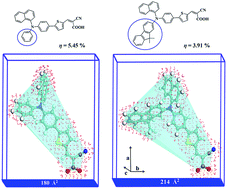The number density effect of N-substituted dyes on the TiO2 surface in dye sensitized solar cells: a theoretical study
Abstract
A series of organic dyes, containing N-substituted carbazole, diarylamine–naphthalene, and diarylamine–fluorene donor for Dye1, Dye2, and Dye3, respectively, and cyanoacrylic acid acceptor bridged by a thiophene fragment for Dye Sensitized Solar Cell (DSCs) applications, is successfully investigated by DFT and TDDFT. Among these dyes, Dye3, with the strongest electron donating ability, shows the most red shift in the UV-Vis absorption spectrum. Moreover, the Dye3@(TiO2)38 complex shows stronger adsorption energy of −19.54 kcal mol−1. Nevertheless, Dye2 has shown the best photovoltaic performance. We measured the molecular volume and molecular width based on the geometries from the PBE functional, together with the double-numerical with polarization performed in the DMol3 program, to investigate the effect of N-substituted donors on the number density of the adsorbed dye, on the TiO2 surface. We found that the bulkiness of the N-substituted donor in Dye3 can dramatically reduce the number density of the adsorbed on the surface. The molecular width and projected area of Dye3 are calculated to be 15.980 Å and 214 Å2, respectively, indicating the more bulky structure compared to Dye2 (molecular width = 14.505 Å and projected area = 180 Å2) which corresponds to the dye uptake of Dye3 (1.38 × 1017 molecule per cm2) being significantly less than of Dye2 (4.55 × 1017 molecule per cm2). Finally, Dye3 with an extra bulky donor exhibits poorer energy conversion efficiency of 3.91% compared to 5.45% of Dye2, under simulated AM 1.5 irradiation (100 mW cm−2).


 Please wait while we load your content...
Please wait while we load your content...